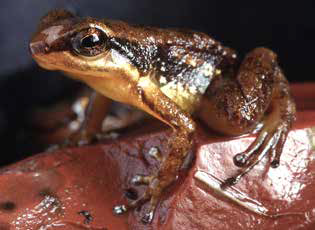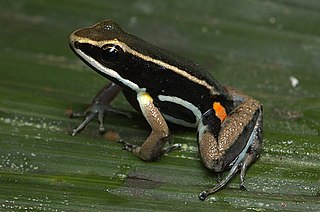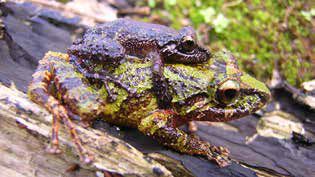
Anomaloglossus breweri is a species of frogs in the family Aromobatidae. It is only know from its type locality, Aprada-tepui in the Bolívar state of southeastern Venezuela. This species was discovered by scientists exploring the inaccessible and remote region of Aprada-tepui. It is a fast-moving frog that lives along creeks and in quiet pools along small streams along the slopes near the cave. The frog is named for Charles Brewer-Carías who collected the type series.

The web-footed coqui, stream coqui, Puerto Rican stream frog, or Karl's robber frog, Eleutherodactylus karlschmidti, is a possibly extinct Puerto Rican frog species in the family Eleutherodactylidae. It was first described by Chapman Grant in 1931, and was named after herpetologist Karl Patterson Schmidt. It is the largest Eleutherodactylus species of Puerto Rico.

Allobates is a genus of frogs in the family Aromobatidae. They are native to the Central and South Americas, from Nicaragua to Bolivia and Brazil, with one species on Martinique.
Aromobates nocturnus, the skunk frog, is a species of critically endangered frog endemic to Trujillo State in Venezuela. It is an extremely rare frog, and no sightings have been recorded since the original description in the early 1990s.

Mannophryne is a genus of frogs native to Venezuela and Trinidad and Tobago. They are sometimes known as the fingered poison frogs. This genus was created in 1992 and corresponds to the former Colostethus trinitatis species group. All species have a dark throat collar.

The Aromobatidae are a family of frogs native to Central and South America. They are sometimes referred to as cryptic forest frogs or cryptic poison frogs. They are the sister taxon of the Dendrobatidae, the poison dart frogs, but are not as toxic as most dendrobatids are.
Atelopus vogli is an extinct species of harlequin frog in the family Bufonidae. It was endemic to Venezuela. It is known from collections in two localities: its type locality, Las Peñas near Hacienda la Trinidad in Aragua, and Montalbán in Carabobo. It was first described as subspecies of Atelopus cruciger. The specific name vogli honours Cornelius Vogl, German priest who was a missionary in Venezuela in 1925–1959. Common name Vogl's harlequin toad has been coined for it.
Aromobates capurinensis is a species of frog in the family Aromobatidae. It is endemic to the Sierra Nevada de Mérida, Venezuela. Its natural habitat is cloud forest. The male protects the eggs that are laid on land. After hatching, the male carries the tadpoles on his back to water where they develop further.
Aromobates leopardalis is a species of frog in the family Aromobatidae. It is endemic to the Mérida of western Venezuela, with one population within the Sierra Nevada National Park. Its natural habitats are páramo grassland and sub-páramo shrubland environments and cloud forest. It is usually found within grasses and frailejones, usually along and within streams.
Aromobates saltuensis is a species of frog in the family Aromobatidae. It is endemic to humid lower montane forest of the Táchira state in western Venezuela. Its natural habitat is humid lower montane Andean forest. The male protects the eggs that are laid on land. After hatching, the male carries the tadpoles on his back to water where they develop further.
Minyobates steyermarki is a species of frog in the family Dendrobatidae endemic to Cerro Yapacana in southern Venezuela. It is also known by the common names of demonic poison frog, demonic poison-arrow frog, or Yapacana's little red frog. It is monotypic in the genus Minyobates.
Aromobates mayorgai is a species of frog in the family Aromobatidae. It is endemic to the Mérida state of western Venezuela. Its natural habitat is cloud forest where it occurs along mountain streams. The male protects the eggs that are laid on land. After hatching, the male carries the tadpoles on his back to water where they develop further.
Aromobates meridensis is a species of frog in the family Aromobatidae. It is endemic to the Cordillera de Mérida near Chorotal, Venezuela.

Pristimantis riveroi is a species of frog in the family Craugastoridae. It is endemic to Venezuela and only known from the region of the type locality in the Serranía del Litoral in the state of Aragua. The specific name riveroi honours Juan A. Rivero, a Puerto Rican herpetologist. Accordingly, common name Rivero's ground frog has been proposed for it.

Stefania breweri, also known as Brewer's carrying frog, is a species of frog in the family Hemiphractidae. It is endemic to Cerro Autana, Venezuela, and only known from a single specimen (holotype). It was named for Venezuelan explorer Charles Brewer-Carías.
Scinax manriquei is a species of frogs in the family Hylidae. It was described in 2004 from Venezuela, the same year as Scinax flavidus was described from Colombia. They are now considered to be synonyms, with Scinax manriquei having the seniority over Scinax flavidus. The species thus defined occurs in the Andean footshills of both Colombia and Venezuela. It has been found in cloud forests as well as in a variety of disturbed habitats.

Anomaloglossus is a genus of frogs in the family Aromobatidae. The genus is endemic to the Guiana Shield in northern South America. It used to be placed in the family Dendrobatidae, and is still placed in that family by some sources. The name of the genus, from the Greek anomalos and glossa (=tongue), refers to the unusual tongue bearing the median lingual process, the only unambiguous phenotypic synapomorphy of this genus.

Rheobates is a genus of frogs in the family Aromobatidae. It is endemic to Colombia. These are cryptically coloured frogs with extensive toe webbing. The name Rheobates is derived from the Greek words rheo and βάτης bátēs, in reference to the riparian habitat of the type species Rheobates palmatus. They are associated with streams in sub-Andean forests and foothills of the Andes at low to medium altitudes.







